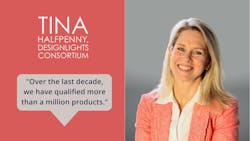As a collective of energy-efficiency program administrators, implementers, policy makers, lighting industry experts, and manufacturers, the DesignLights Consortium (DLC) works to collaborate, facilitate, and liaison with energy-efficiency stakeholders and members. Over the past 10 years, the consortium has created technical requirements and a qualified products list (QPL) for LED lighting products resulting in domino effects that have influenced product performance, deployment, and adoption of commercial LED lighting practices. Upcoming initiatives will continue to inform the way in which we support the COP 28 climate pledge to double energy efficiency by 2030.
Market transformation
The market transformation of LEDs has had a tremendous impact on energy efficiency over the last decade. Based on U.S. Department of Energy (DOE) data and our team’s analysis, commercial and industrial buildings in the U.S. and Canada saved approximately 1,000 TWh of energy from 2010 to 2022 thanks to the transition to LED lighting technology. This movement also reduces mercury pollution from fluorescent lighting in our waste streams.
In the early days of the DLC, we developed our requirements to focus on efficacy — the amount of useful light output per unit of electricity — with regular increases that aligned with the pace of technology. Over time, LED luminaire and lamp efficacy has increased by 30–40% depending on the type of product. The higher efficacy value signifies greater energy efficiency and more light output for the power consumed, saving commercial and industrial customers energy and money. Over the years, our work has evolved to include advances in critical areas of lighting quality, such as color, glare, and controllability for both light preferences and energy savings.
DOE invested in technology and research, and agencies like Pacific Northwest National Laboratory delivered state-of-the-art science, while standards bodies such as the Illuminating Engineering Society and National Electrical Manufacturers Association have delivered performance, safety, illumination levels, and testing standards that further enabled collaboration with stakeholders. Furthermore, the DLC established a framework to align our utility members' efficiency goals — the QPL — which has been adopted by 75% of North American energy-efficiency programs. Through this framework, our members were able to achieve efficiencies by pooling their resources for research, collaborating on a single set of requirements and utilizing one objective list of qualified products to provide consistent offers.
The future: Efficiency and ecosystem in balance
The QPLs continue to shift toward higher quality and efficiency. Over the last decade, we have qualified more than a million products, but thanks to lighting advances, we’ve narrowed that to over 300,000 products on the list today that meet our performance requirements for efficacy, quality, and controllability. The Solid-State Lighting QPL is our largest resource for energy-efficiency programs. Today, 75% of qualified products have integrated controls and 99.5% of qualified products are dimmable, increasing energy savings potential. In horticulture, DLC-qualified LED lighting fixtures are over 35% more efficacious than incumbent, non-LED fixtures. Horticultural Technical Requirements V3.0, which rolled out last March, featured the program’s first efficacy bump, increasing potential energy savings with DLC-qualified products by at least 20%.
Our QPLs have influenced commercial and industrial energy-efficiency programs. We also educate policy makers and building owners/operators on the potential of networked lighting controls, the possibilities for more efficient horticulture lighting, and effective ways to mitigate light pollution by conducting or commissioning independent, unbiased research and by creating tools. One research example is our August 2023 “Economic Potential of Networked Lighting Controls in Commercial Buildings,” and an example of a tool is our light pollution ordinances map, which tracks local outdoor ordinances and bylaws across North America.
DLC has added more products to our LUNA QPL, continuing to double down on light pollution mitigation to support ecosystems and human communities while still reducing energy consumption. Ecosystem-level harm is preventable with more education and quality alternatives for outdoor lighting. This year, we’re working toward a standard and requirements for amber outdoor lights for the most sensitive environments. There are nearly 300 lighting ordinances in the U.S. alone and growing interest in making better choices regarding light pollution and keeping our skies dark for human health and wellness, views of the night sky, and protection of our natural ecosystems.
DLC has updated our mission and vision statements to expand our focus beyond lighting quality and our goals beyond saving energy. As a consortium, we are working together to encompass the reduction of light pollution and carbon emissions, as well as transforming indoor agriculture to be more efficient. We plan to evolve the QPLs to be more user friendly to broader audiences. We want these resources to help anyone looking to save energy, reduce carbon, or mitigate light pollution.
DLC is moving full speed ahead to keep scaling our impact and gather more voices and ideas in the energy community. Passion and the power of working together can achieve greater strides toward decarbonization.
Share your thoughts via social media or by emailing [email protected].
*This version has been expanded from the column published in the March/April 2024 issue of LEDs Magazine.
CHRISTINA HALFPENNY is executive director and CEO of the DesignLights Consortium, responsible for strategic planning, stakeholder engagement and collaboration, and improvement in business systems for the nonprofit.
Follow our LinkedIn page for our latest news updates, contributed articles, and commentary, and our Facebook page for events announcements and more. You can also find us on the X platform.





